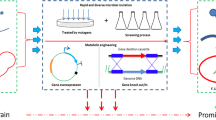Abstract
(R)-3, 5-Bis(trifluoromethyl)phenyl ethanol is a key chiral intermediate for the synthesis of aprepitant. Through a genome mining approach, an NADPH-dependent short-chain dehydrogenases derived from Burkholderia cenocepacia (Bc-SDR) was discovered with excellent anti-Prelog’s stereoselectivity of reducing 3, 5-bis(trifluoromethyl) acetophenone. The enzyme with 247 amino acids was successfully expressed in Escherichia coli and the molecular weight was about 26 kDa. Optimization of reaction conditions showed that the optimum temperature and pH of the enzyme was 25 °C and pH 7.0, respectively. Strong enhancement of enzyme activity was observed in the presence of 1 mM Mn2+. In addition, Bc-SDR exhibited (R)-selective enantioselectivity toward acetophenone derivatives, which makes it a potential catalyst for obtaining aromatic chiral alcohols as useful blocks in pharmaceutical applications.






Similar content being viewed by others
References
Moore, J. C., Pollard, D. J., & Kosjek, B. (2007). Advances in the enzymatic reduction of ketones. Accounts of Chemical Research, 40, 1412–1419.
Bornscheuer, U. T., Huisman, G. W., & Kazlauskas, R. J. (2012). Engineering the third wave of biocatalysis. Nature, 485, 185–194.
Huisman, G. W., Liang, J., & Krebber, A. (2010). Practical chiral alcohol manufacture using ketoreductases. Current Opinion in Chemical Biology, 14, 122–129.
Noey, E. L., Tibrewal, N., & Jiménez-Osés, G. (2015). Origins of stereoselectivity in evolved ketoreductases. Proceedings of the National Academy of Sciences, 112, E7065–E7072.
Wang, P., Cai, J. B., & Ouyang, Q. (2011). Asymmetric biocatalytic reduction of 3,5-bis (trifluoromethyl) acetophenone to (1R)-[3,5-bis (trifluoromethyl) phenyl] ethanol using whole cells of newly isolated Leifsonia xyli HS0904. Applied Microbiology and Biotechnology, 90, 1897–1904.
Gelo-Pujic, M., Le Guyader, F., & Schlama, T. (2006). Microbial and homogenous asymmetric catalysis in the reduction of 1-[3,5-bis (trifluoromethyl) phenyl] ethanone. Tetrahedron: Asymmetry, 17, 2000–2005.
Brands, K. M. J., Payack, J. F., & Rosen, J. D. (2003). Efficient synthesis of NK1 receptor antagonist aprepitant using a crystallization-induced diastereoselective transformation. Journal of the American Chemical Society, 125, 2129–2135.
Nakade, S., Ohno, T., & Kitagawa, J. (2008). Population pharmacokinetics of aprepitant and dexamethasone in the prevention of chemotherapy-induced nausea and vomiting. Cancer Chemotherapy and Pharmacology, 63, 75–83.
Kurbanoglu, E. B., Zilbeyaz, K., & Taskin, M. (2009). Total production of (R)-3, 5-bistrifluoromethylphenyl ethanol by asymmetric reduction of 3,5-bis (trifluoromethyl)-acetophenone in the submerged culture of Penicillium expansum isolate. Tetrahedron: Asymmetry, 20, 2759–2763.
Gai, P., Tang, C., Liu, J., Liu, Y., Zhang, C., & Wu, Z. (2013). Asymmetric anti-Prelog reduction of 3,5-bis(trifluoromethyl)-acetophenone by microbacterium oxydans C3. Chinese Journal of Applied & Environmental Biology, 19, 37–42.
Li, J., Wang, P., He, J. Y., Huang, J., & Tang, J. (2013). Efficient biocatalytic synthesis of (R)-[3,5-bis (trifluoromethyl) phenyl] ethanol by a newly isolated Trichoderma asperellum ZJPH0810 using dual cosubstrate: ethanol and glycerol. Applied Microbiology and Biotechnology, 97, 6685–6692.
Wang, N., Huang, J., & Luo, H. (2013). Purification and characterization of a new carbonyl reductase from Leifsonia xyli HS0904 involved in stereoselective reduction of 3, 5-bis (trifluoromethyl) acetophenone. Journal of Molecular Catalysis B: Enzymatic, 92, 1–6.
Wang, N. Q., Sun, J., & Huang, J. (2014). Cloning, expression, and directed evolution of carbonyl reductase from Leifsonia xyli HS0904 with enhanced catalytic efficiency. Applied Microbiology and Biotechnology, 98, 8591–8601.
Liu, Y., Tang, T. X., & Pei, X. Q. (2014). Identification of ketonereductase ChKRED20 from the genome of Chryseobacterium sp. CA49 for highly efficient anti-Prelog reduction of 3,5-bis(trifluoromethyl)acetophenone. Journal of Molecular Catalysis B: Enzymatic, 102, 1–8.
Li, H. M., Moncecchi, J., & Truppo, M. D. (2015). Development of an immobilized ketoreductase for enzymatic (R)-1-(3,5-Bis(trifluoromethyl)phenyl)ethanol production. Organic Process Research & Development, 19, 695–700.
Chen, K., Li, K., & Deng, J. (2016). Carbonyl reductase identification and development of whole-cell biotransformation for highly efficient synthesis of (R)-[3,5-bis (trifluoromethyl) phenyl] ethanol. Microbial Cell Factories, 15, 191.
Prelog, V. (1964). Specification of the stereospecificity of some oxido-reductases by diamond lattice sections. Pure and Applied Chemistry, 9, 119–130.
Singh, A., Basit, A., & Banerjee, U. C. (2009). Burkholderia cenocepacia: a new biocatalyst for efficient bioreduction of ezetimibe intermediate. Journal of Industrial Microbiology & Biotechnology, 36, 1369.
Yıldız, T. (2015). An oxazaborolidine-based catalytic method for the asymmetric synthesis of chiral allylic alcohols. Tetrahedron: Asymmetry, 26, 497–504.
Hoffmann, F., & Maser, E. (2007). Carbonyl reductases and pluripotent hydroxysteroid dehydrogenases of the short-chain dehydrogenase/reductase superfamily. Drug Metabolism Reviews, 39, 87–144.
Kallberg, Y., Oppermann, U., & Jörnvall, H. (2002). Short-chain dehydrogenase/ reductase (SDR) relationships: a large family with eight clusters common to human, animal, and plant genomes. Protein Science, 11, 636–641.
Oppermann, U., Filling, C., & Hult, M. (2003). Short-chain dehydrogenases/reductases (SDR): the 2002 update. Chemico-Biological Interactions, 143, 247–253.
Author information
Authors and Affiliations
Corresponding author
Ethics declarations
Conflict of Interest
The authors declare that they have no conflict of interest.
Electronic supplementary material
ESM 1
Fig. S1 Multiple sequence alignment of the target sequence (NCBI Reference Sequence: ANZ75577.1, ANZ77886.1, ANZ77893.1, XP_002489352.1, XP_002492297.1, XP_002493760.1, XP_002494195.1, WP_006481546.1, WP_006481604.1, WP_006481801.1, WP_006483065.1, WP_006485075.1, WP_006485158.1, WP_006488202.1, WP_012336650.1, WP_012492403.1, WP_050013528.1, WP_058903664.1, WP_060214413.1, WP_077189930.1) with the template sequence (Leifsonia xyli HS0904) Fig. S2 Sequence alignment of the target sequence (Burkholderia cenocepacia) with the template sequence (Leifsonia xyli HS0904). (DOCX 9094 kb)
Rights and permissions
About this article
Cite this article
Yu, S., Li, H., Lu, Y. et al. A Catalyst from Burkholderia cenocepacia for Efficient Anti-Prelog’s Bioreduction of 3,5-Bis(Trifluoromethyl) Acetophenone. Appl Biochem Biotechnol 184, 1319–1331 (2018). https://doi.org/10.1007/s12010-017-2628-8
Received:
Accepted:
Published:
Issue Date:
DOI: https://doi.org/10.1007/s12010-017-2628-8




